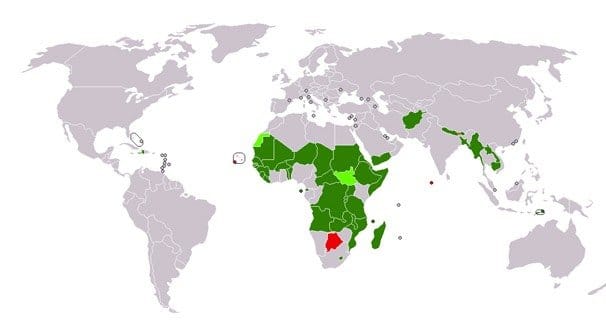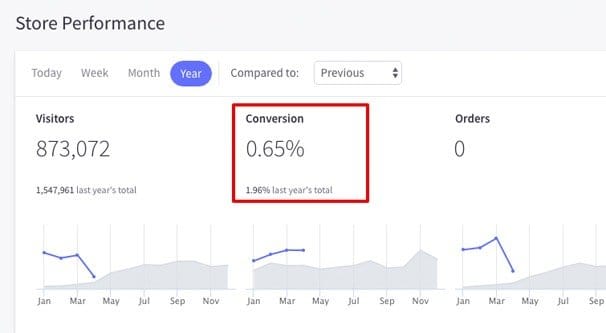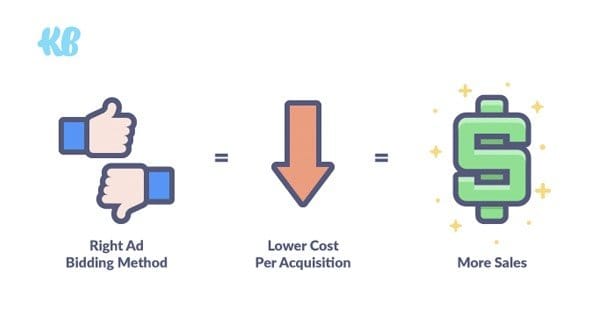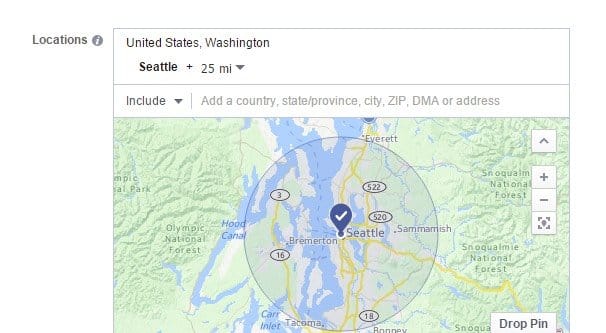 Written by ContentPowered.com
Written by ContentPowered.com
For once in my life, I’m going to start off an article with the answer to the question in the title. Or, in this case, with the information right up front. I’m doing this today for two reasons. First, I know some people actually want to know this, so giving them the list up-front gets them what they want right away. Second, those of you who are skeptical or see something off about the list will continue to read, and understand why this list is mostly valueless to you.
The Cheapest Countries on Facebook
There’s no official listing or ranking of what countries are cheapest. You can’t even rely on this list specifically, because the price of running ads in a given location can fluctuate wildly based on a wide range of factors. The industry, the competition, the keywords, the target, your quality score, your reach; all of this has an impact.
Anyway, here’s the list of the cheapest countries on Facebook to target with advertising.
Trinidad and Tobago, India, Pakistan, Philippines, Bangladesh, Egypt, Thailand, South Africa, Poland, Turkey, Brazil, Kenya, Cameroon, Romania, Malaysia, Zimbabwe, Ghana, Sierra Leone, Mexico, Tanzania, Algeria, Uganda, Nigeria, Tunisia, Indonesia, Bulgaria, Albania, Macedonia, Montenegro, Georgia, Serbia, Kazakhstan, Moldova, Ukraine.
Notice Something?
Notice anything about that list? Most of them aren’t what you would consider first world countries. They aren’t explicitly third world countries, though the definition there can vary depending on what definition you’re using of the term. Most of them aren’t primarily English, though many of them have English represent a sizable portion of the population just because of how widespread the language is globally.
The primary thing you should notice, though, is just how out of the way most of these countries are from what you might consider the beaten path.
Imagine a scenario where you’re a relatively small craft and hobby shop based in Omaha, Nebraska. You’re doing well for yourself; you have three branches throughout the city, each one doing brisk business. Your Facebook page has been suffering, though; you don’t have very many followers. You decide you want to get as many new followers as possible for as cheap as possible, so you decide to run ads.
For cheap ads, for literal “one penny per follower” style ads, you can easily target all of the above countries. You’ll probably get hundreds or thousands of followers very quickly. It’ll look great on your Facebook page! Right up until anyone actually bothers to check your followers list and sees you right up there with these folks. Who knows, you might even end up on a local version of that list.
The Problem with Cheap Countries
There are a lot of problems with fake followers, which is really what you’re getting here. Even if every single person who follows you because of these ads is a real person on the other end, who cares? Sure, you only spent $1 to get 1,000 followers, but how many of those followers are going to spend $1 on your products?
The answer here is zero. Zero of those followers will ever spend money on your products. You know why? You aren’t shipping your products from Nebraska to Kenya. You aren’t providing art supplies to people in the Ukraine. You aren’t honoring purchases made by people in Serbia. International shipping is expensive, it’s slow, it’s a giant hassle, and most businesses simply aren’t going to try it.
When you’re talking about cheap countries to target on Facebook, what you’re talking about is a way to waste money. You don’t need cheap followers, you don’t need cheap exposure, you need REAL followers and REAL exposure.
The only reason you would want to target ultra-cheap followers like this is if you’re selling the account later and want to make it look like it has a ton of followers, or if you’re earning some kind of income from your clicks. Since you don’t get paid as a publisher on Facebook, it’s really just that other option, which is against the Facebook terms of service. Even if it wasn’t, you’d still run up against the issue that people know what fake followers look like. No one will believe your English meme page has 150,000 legitimate fans from Ghana or whatever. That’s just not natural behavior.
Instead of just targeting cheap countries to get your costs down, why not use some actually useful methods to decrease costs that can still lead you to customers and engaged audience members?
How to Lower the Cost of Facebook Ads Safely
Cheap ads are entirely possible without exploiting bad countries or clickfarms. You probably won’t reach the penny click level, but who knows, maybe you can in the right niche. The important part is that you’ll have a return on investment greater than nothing if you use these techniques.
Learn about your audience. The more you know about your audience, the more narrowly you can target your ads. When your targeting is very narrow, you’re not wasting money on people who are less likely to be interested.
Learn the location of your audience. In our craft store example, you’d be targeting Nebraska as a whole, or Omaha as a whole, or even just specific zip codes within the greater Douglas County area. You might be able to reach out to Lincoln, up to Sioux City, or all the way out to somewhere like Des Moines or Kansas City if you’re looking to expand into those areas. Get brand awareness up, then open a new store.
Learn other demographic information about your audience. Your craft store might focus more on fabric arts, which tend to be a female-dominated niche. You might see a significant uptick in users in the older age ranges, though crafts are still popular among young people. You might even want to learn the average education, income, and other demographics about your audience.
The more closely you can target your idea customer, the higher the conversion rate for your ads will be. It might be more expensive, but who cares if you’re still making a profit? Compare these scenarios:
- You spend $100 on ads focused on selling products. With penny clicks from Bangladesh, you get 10,000 clicks. You don’t sell to Bangladesh, so your total profit from those users is $0, leaving you at -$100.
- You spend $100 on ads focused on selling products. You target the greater Omaha area and find that your clicks are nearly $.50 each. For your money, you end up with 200 clicks. However, 5 of those users immediately purchase a $20 product from your store. It’s a low conversion rate, but you have already made $100 from those customers, putting you at an even $0.
In one scenario, you have lost your initial investment and you have absolutely no chance of making any money from it. The clicks simply ate up bandwidth, added to your follower count, and drained your advertising budget.
In the other scenario, you haven’t made any money, but you’ve proven demand and you’ve settled on even. With a few tweaks to better match your audience to the people who clicked, you can make a profit from your ads. Plus, the people who clicked but didn’t buy might still buy at a later date, or might come into your store when they drive by later. If nothing else, they are more aware of who you are and what you do, so they can recommend you to a friend if a friend expresses interest.
Learn about your ads. Every aspect of your ad, from the targeting to the image to the text, is something you can optimize. Obviously, targeting is going to have a huge impact, but so will the actual call to action text you include. Learn and love split testing.
With split testing, what you want to do is make two or more variations on one base ad. Keep every element of the ad the same except one. Change that one element and run both ads for the same amount of time with the same budget. This will give you as close to an equal ad run as possible. Once you’ve run them both long enough to get a statistically relevant sampling of data, you can fairly easily see which one is better.
Take that better ad and make it your new baseline. Spin off a new variation testing something else – different copy, a different image, a different URL, whatever – and repeat.
The process of incrementally testing your ad performance is something you’re going to be doing constantly. Most pro advertisers are swapping out ad variations on a weekly basis, and some – those with large audiences and large advertising budgets – might even be working on a daily basis.
Social Media Examiner has a pretty good rundown of different aspects of ads you can optimize on an individual basis. They don’t go into great detail about each of them, but it’s enough to get you started.
Oh, and as a footnote, make sure you’re always picking an appropriate objective for your ads. If you want people to buy products, don’t run “clicks to website” ads just because the individual clicks are cheaper. You have no guarantee that the people clicking are going to buy, and you’re paying for those clicks anyway. Use a conversions objective and you’ll only be paying for the actual conversions, which can virtually guarantee you at least a positive ROI.
Keep in mind that Facebook optimizes ads for the objective regardless of other targeting. They assume you’ve chosen correctly. If you’re using the wrong objective, even with the right kind of targeting, Facebook may be working against you by reaching the people most likely to perform your objective rather than what you actually want. Their ad system can’t read minds, after all.
Know your ad frequency. One thing people often overlook is the frequency of ad display to an audience. Frequency is the number of times, on average, each individual person in your audience sees your ad. If you’re targeting too wide an audience, your frequency will be well below 1, meaning a good portion of your audience never sees your ad. This can be fine in some situations, like brand awareness, but it’s generally better to shoot for smaller audiences to get a more complete saturation.
A frequency below 1 means people are being left out, and means your ads are inefficient. Meanwhile, a frequency above 1 means your users are seeing your ads more than once. Depending on the ad, this might be ideal, or it might be annoying. Generally, if your frequency is well above 3 or 4, you’re running your ads too heavily and they’re going to be experiencing incredibly diminishing returns.
Keep an eye on everything. Total awareness of what your ads are doing and how they’re performing, on an individual basis and as an aggregate, is important. If you don’t know how everything is working, you don’t know if you’re improving or if you’re stagnating. If your only metric is return on investment, it can make low-volume and sub-par ads look better than they are. If your only metric is profit, it can lead you to making decisions that alienate your audience in the long run. If your only metric is followers, you end up with all sorts of people following you when they have no intention of buying from your business. Everything must be kept in balance.





Thanks for the good overview! I agree that lots of cheap likes don’t help if you’re selling products, but if you run a media company I could see cheap likes having a high ROI since you are paid on impressions, and you can also boost the reach of your content. I’ve also seen people use cheap countries to generate social proof for product-focused posts before promoting them to buyer countries.